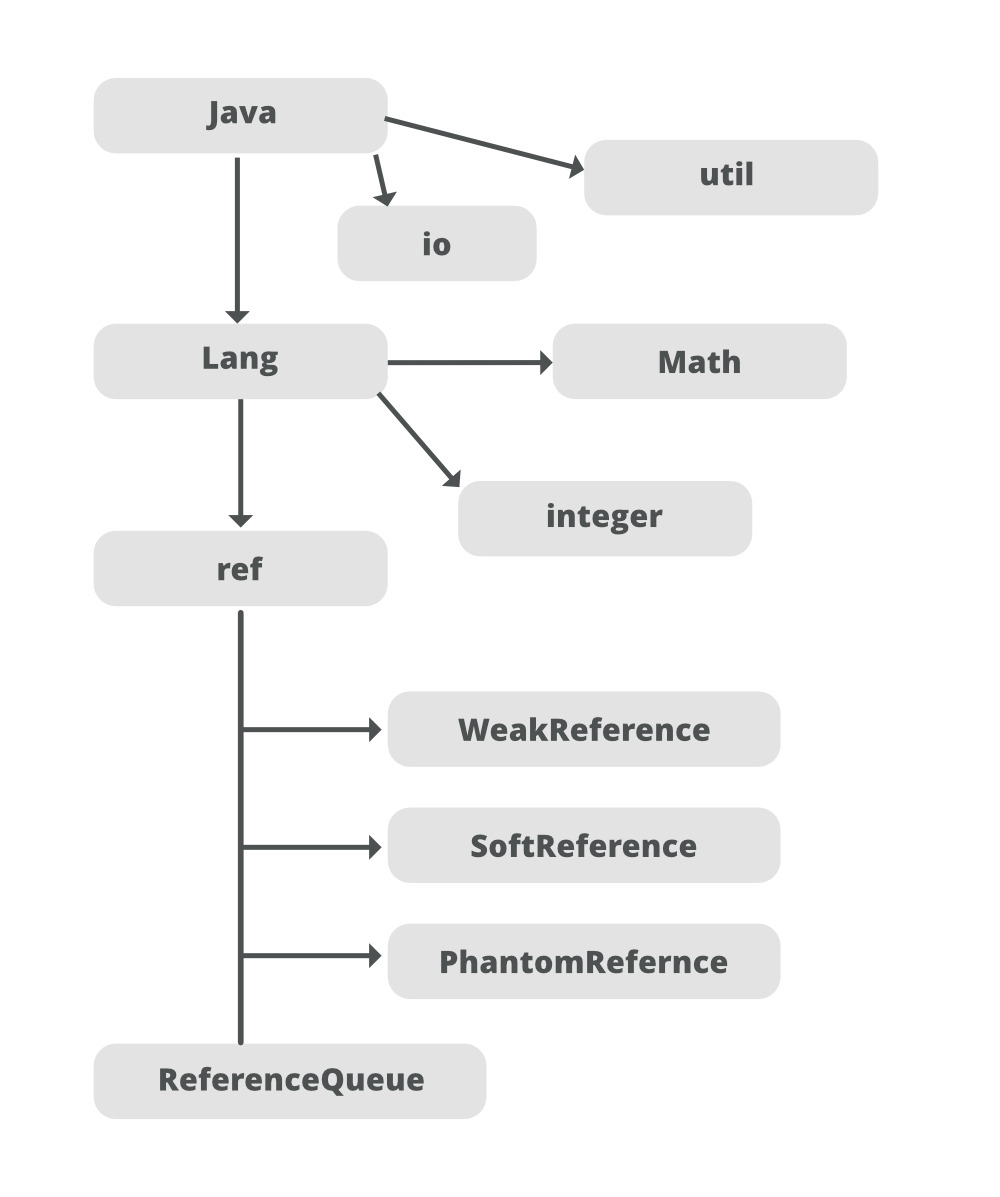當我們在Java中創建一個對象時,默認情況下對象是強的。要創建虛擬引用對象,我們必須向 JVM 顯式指定它。幻像引用對象是由於幻像引用對象有資格進行垃圾回收而創建的,但它不會立即被收集。相反,它被推入ReferenceQueue,以便可以清除所有此類排隊的引用。

該類的構造函數如下表所示
| 構造函數參數 | 構造函數說明 |
|---|---|
| PhantomReference (T,ReferenceQueue <T> q): | 創建一個新的幻像引用,該引用引用給定的對象並注冊到給定的隊列中。可以使用空隊列創建幻像引用,但這樣的引用是完全無用的:它的 get 方法將始終返回 null,並且由於它沒有隊列,因此永遠不會入隊。 |
從Reference類繼承的方法如下:
| 方法名稱 | 方法說明 |
|---|---|
| get() | 返回此引用對象的指示對象。由於幻像引用的指示對象始終不可訪問,因此此方法始終返回 null。 |
| clear() | 清除該引用對象。調用此方法不會導致此對象入隊。 |
| enque() | 將此引用對象添加到其注冊的隊列(如果有)。 |
| isEnqueued() | 告知此引用對象是否已被程序或垃圾Collector排隊。 |
示例 1:
Java
// Java Program to illustrate PhantomReference class
// of java.lang.ref package
// Importing PhantomReference and ReferenceQueue classes
// from java.lanf.ref package
import java.lang.ref.PhantomReference;
import java.lang.ref.ReferenceQueue;
// Class 1
// Helper class
class HelperClass {
// Method inside HelperClass
void Display()
{
// Print statement whenever the function is called
System.out.println("Display Function invoked ...");
}
}
// Class 2
// Main class
public class GFG {
// MyClass
// Main driver method
public static void main(String[] args)
{
// Creating a strong object of HelperClass
HelperClass obj = new HelperClass();
// Creating a reference queue of HelperClass type
ReferenceQueue<HelperClass> rq
= new ReferenceQueue<>();
// Creating a phantom reference object using rq
PhantomReference<HelperClass> pobj
= new PhantomReference<>(obj, rq);
// Display message only
System.out.println(
"-> Calling Display Function using strong object:");
// Calling the display method over the object of
// HelperClass
obj.Display();
// Display message for better readability
System.out.println("-> Object set to null");
obj = null;
// Getting elements in PhantomReference object
// using standard get() method
obj = pobj.get();
// Display status of objects after fetching
// PhantomReference class objects
System.out.println(
"-> Object status after fetching from PhantomReference now : "
+ obj);
// Display message only
System.out.println(
"-> Calling Display Function after retrieving from weak Object");
// Try block to check for exceptions
try {
obj.Display();
}
// Catch block to handle the exceptions
catch (Exception E) {
// Print message when an exception occurred
System.out.println("-> Error : " + E);
}
}
}輸出
-> Calling Display Function using strong object: Display Function invoked ... -> Object set to null -> Object status after fetching from PhantomReference now : null -> Calling Display Function after retrieving from weak Object -> Error : java.lang.NullPointerException
Hence, it is seen that unlike Soft and Weak References, Phantom Reference always returns null.
示例 2:
Java
// Java Program to illustrate PhantomReference class
// of java.lang.ref package
// Importing Phantomreference and RefereenceQueue classes
// from java.lang.ref package
import java.lang.ref.PhantomReference;
import java.lang.ref.ReferenceQueue;
// Class 1
// HelperClass
class X {
// Method
// To print simply
void show()
{
// Display message whenever
// show() method is called
System.out.println("show () from X invoked..");
}
}
// Class 2
// Main class
public class GFG {
// Main driver method
public static void main(String[] args)
{
// Creating default object of X class
X obj = new X();
// Creating new reference queue object
ReferenceQueue<X> rq = new ReferenceQueue<X>();
// Creating an object of PhantomReference class
// of X class type with RefereneQueue object
// reference queue
PhantomReference<X> phantomobj
= new PhantomReference<X>(obj, rq);
// Display message
System.out.println(
"-> Trying to retrieve object from Phantom Reference :");
// Try block to check for exceptions
try {
// this will always throw error as it has been
// collected
// by the garbage collector
phantomobj.get().show();
}
// Catch block to handle the exceptions
catch (Exception e) {
// Print and display the exception
System.out.println(e);
}
}
}輸出
-> Trying to retrieve object from Phantom Reference : java.lang.NullPointerException
相關用法
- Java java.lang.ref.Reference用法及代碼示例
- Java java.lang.ref.WeakReference用法及代碼示例
- Java java.lang.ref.SoftReference用法及代碼示例
- Java java.lang.ref.ReferenceQueue用法及代碼示例
- Java java.lang.reflect.AccessibleObject.getAnnotation()用法及代碼示例
- Java java.lang.reflect.AccessibleObject.getAnnotations()用法及代碼示例
- Java java.lang.reflect.AccessibleObject.getDeclaredAnnotations()用法及代碼示例
- Java java.lang.reflect.AccessibleObject.isAccessible()用法及代碼示例
- Java java.lang.reflect.AccessibleObject.setAccessible()用法及代碼示例
- Java java.lang.reflect.Array.get()用法及代碼示例
- Java java.lang.reflect.Array.getBoolean()用法及代碼示例
- Java java.lang.reflect.Array.getByte()用法及代碼示例
- Java java.lang.reflect.Array.getChar()用法及代碼示例
- Java java.lang.reflect.Array.getDouble()用法及代碼示例
- Java java.lang.reflect.Array.getFloat()用法及代碼示例
- Java java.lang.reflect.Array.getInt()用法及代碼示例
- Java java.lang.reflect.Array.getLength()用法及代碼示例
- Java java.lang.reflect.Array.getLong()用法及代碼示例
- Java java.lang.reflect.Array.getShort()用法及代碼示例
- Java java.lang.reflect.Array.newInstance()用法及代碼示例
- Java java.lang.reflect.Array.set()用法及代碼示例
- Java java.lang.reflect.Array.setBoolean()用法及代碼示例
- Java java.lang.reflect.Array.setByte()用法及代碼示例
- Java java.lang.reflect.Array.setChar()用法及代碼示例
- Java java.lang.reflect.Array.setDouble()用法及代碼示例
注:本文由純淨天空篩選整理自varunkedia大神的英文原創作品 java.lang.ref.PhantomReference Class in Java。非經特殊聲明,原始代碼版權歸原作者所有,本譯文未經允許或授權,請勿轉載或複製。
